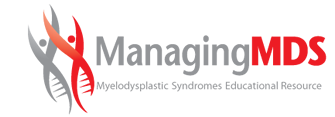Hi, I'm Dr. Rami Komrokji, and I'm frequently asked, what are the key investigational studies to keep an eye on in higher-risk MDS patients in the post-AZA setting? I think it's an interesting time and exciting time for researchers in the MDS field that hopefully finally we are moving the bar from use of hypomethylating agents in higher-risk MDS. As you will know, higher-risk MDS patients have unfortunately a median survival of two years or less in general. We tend to think of allogeneic stem cell transplant as the only curative option for those patients. In reality, probably only 10% to 20% of MDS patients will undergo allogeneic stem cell transplant because of age and presence of other comorbidities. The mainstay for treatment had been the hypomethylating agents. The original study, AZA-001 study, suggested around 24 median survival. In real-life experience, we've never been able to duplicate that. The standard currently with hypomethylating agents is to expect overall responses in the range of 40% to 50%, less than 20% of the patients achieving a complete response, and the median survival spanning from a year to year and a half in higher-risk MDS patients. There is definitely unmet need to move the bar and improve that. Hopefully, finally, we are getting that and there are several promising agents. I'll briefly mention the ones that are in phase 3 and had shown promising results in phase 1 and phase 2.
To start with, APR-246. This is an agent that has been developed for patients with p53 mutation. A subset of MDS patients that are known to have, unfortunately, a very bad outcome with a median survival of four to six months and a very short response to hypomethylating agents. In the phase 1/phase 2 data, we observed more than 50% complete responses, and APR-246 had finished the phase 3 trial that hopefully we'll hear results by the end of this year or early next year. And if positive, will lead to approval of APR-246 in patients with p53 mutation. It's also been explored obviously in AML and in other combinations. The other drug to mention also briefly is magrolimab. This is an anti-CD47 antibody. CD47 is a receptor on the cells that will prevent macrophages engulfing or eating the cells, so it's called the don't-eat-me signal, which tends to be overexpressed in MDS and AML patients. Magrolimab is a monoclonal antibody that will block that signal and allow the macrophages to engulf or eat the cells. And again, in a phase 1/phase 2 study looking at MDS and AML patients, it had shown promising activity with again more than 50% complete response rate, durable responses, and also a signal of response in patients with p53 mutation, while it seems that targeting the innate immune system is agonistic from the presence of somatic mutations. So magrolimab now is starting a phase 3 trial in MDS as well as a phase 3 trial in AML in comparison to AZA/venetoclax in AML.
The third drug to discuss is pevonedistat. This is a neddylation inhibitor that was presented at ASCO and EHA meeting looking at a group of patients with higher-risk MDS, oligoblastic AML with blasts less than 30%, as well as CMML. The primary endpoint of the study was event-free survival, particularly in patients with higher-risk MDS, that primary endpoint was met. The responses again were doubled compared to azacitidine. This was a randomized phase 2 trial and the pevonedistat is going into a phase 3 trial. The appeal of using pevonedistat is the lack of myelosuppressive activity, so it could be appealing to have pevonedistat in combination with other drugs.
And finally, obviously to discuss venetoclax. That is now approved by the FDA for treatment of AML in patients that are unfit for intensive chemotherapy. There is obviously evolving data in MDS patients in combination with hypomethylating agents. Upfront, the dosing is slightly different from AML where two weeks of venetoclax dosing seems to be the dose in MDS compared to the continuous dosing in the first cycle in AML. Promising early activity AZA/VEN compared to historical AZA. And again, this is going into randomized trials, but also some data presented by Dr. Amer Zeidan and by our group in collaboration with Memorial Sloan Kettering, looking at patients after HMA failure coming back with venetoclax as an add-back strategy showing 20% to 30% responses, and maybe potentially as a bridge to take patients to transplant. So those are the most promising four agents. I think for the first time, we are excited to see doubling or tripling the response rates in phase 1/phase 2 trials. For the first time, we are moving to have four clinical phase 3 trials in MDS starting to talk about achieving the minimal residual disease. And I think the next step, as we move the bar up, is going to be triplets or quadruplets use of those novel agents in higher-risk MDS, which hopefully will translate finally to improving that bar of one- to one-and-a-half-year survival in higher-risk MDS patients, and improve the outcomes, even in the context of allogeneic stem cell transplant. Thank you for viewing this activity.
